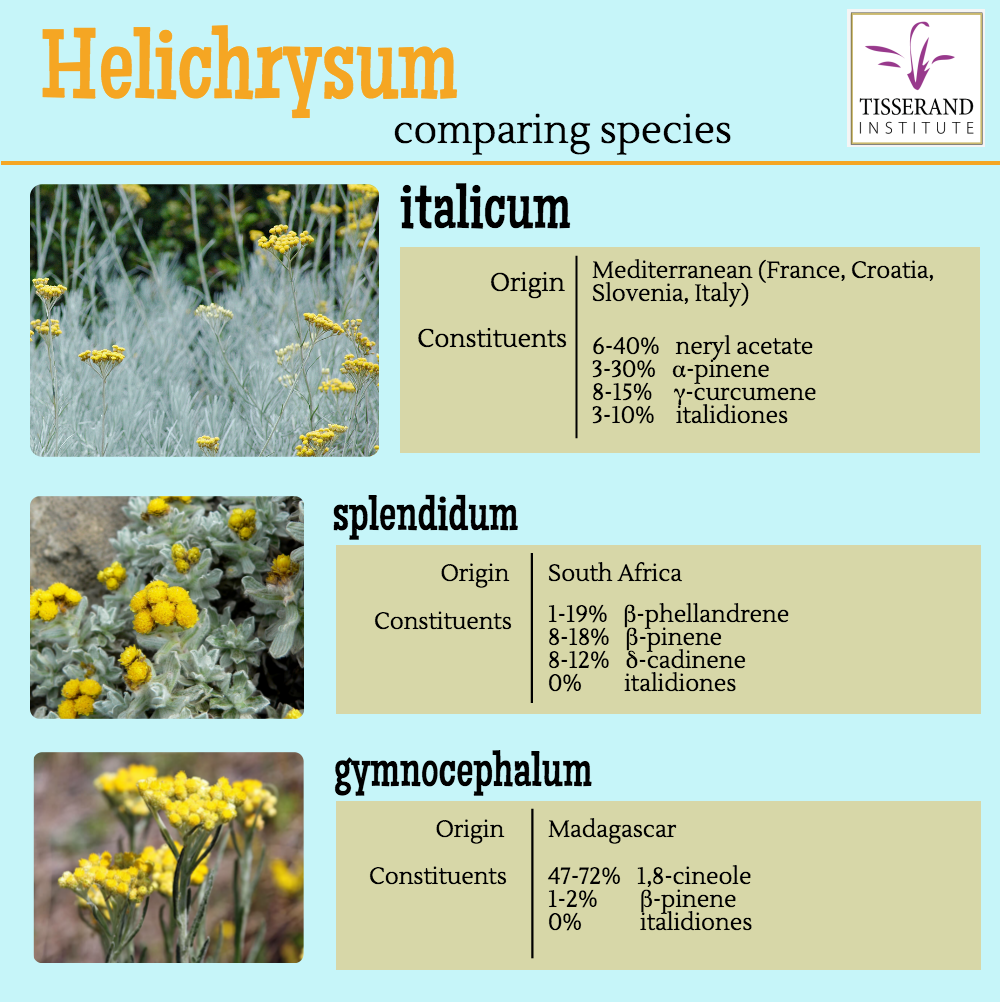Not all helichrysums are created equal – today we compare the three species that are most commonly used for essential oil production.
The best known and most sought-after species is Helichrysum italicum. Also known as Immortelle or curry plant, this tiny shrub grows in the Mediterranean (Italy, France, Croatia, Slovenia). Its two chemotypes are rich in either neryl acetate or alpha-pinene, and it also contains gamma-curcumene – a spicy constituent that is sometimes confused with curcumin (they are not the same). Italicum oil also contains italidiones, constituents that are not found in any other essential oil, nor are they found in other species of helichrysum. The italidiones are considered to be mainly responsible for its therapeutic properties. Neryl acetate is also not found in the other two helichrysums featured here.
These are H. splendidum, native to South Africa, and H. gymnocephalum from Madagascar. H. splendidum is rich in beta-phellandrene and grows much more abundantly than H. italicum. H. gymnocephalum contains a large percentage of 1,8-cineole, which is also the major constituent of Eucalyptus globulus.
Both H. spledidum and H. gymnocephalum possess therapeutic properties, but the great differences in chemistry tell us that these will also be very different. If you’re looking for something with similar effects to Eucalyptus globulus, then H. gymnocephalum would be a good choice. But if you’re looking for “Helichrysum oil” because you’ve heard good things about its effects on the skin, then you want H. italicum.
They may sound similar, but these species of helicrysum oil could not be more different.


These snippets of info are not very comprehensive. They tease and lead to expensive courses.
Hi Jenny, they are, as you said, snippets of information. These infographics are designed to show one tiny aspect of aromatherapy that we feel needs to be addressed in a way that can easily be shared. They are not supposed to provide a full picture. For a more comprehensive view of how essential oils work, there are several well-researched and thoroughly reviewed posts in our blog section.
Thank you for this–it is easy to read and augments and supports ongoing exploration. While I love your book–this is easier to share 🙂
Marni
I have read that helichrysum is beneficial for improving both hearing and sight.. which would you suggest?
There are no essential oils at all which have known benefits for either hearing or sight. Where did you read this?
I have few friends, who improved their hearing with Helichrysum and frankincense and the improvement was significant for all of them.
I’m curious to know how did Clary sage got its Lain name of Salvia Sclarea? According to my research, past generations were not using neat essential oils, but rather very weak steamed dilutions of them from the plants in water to wash eyes for great vision benefit.
I wrote a blog post about this here: https://roberttisserand.com/2013/02/essential-oils-and-eye-safety/
“The reference to clary sage probably derives from 17th century European herbalists, but this refers to using clary sage seeds, or mucilage made from them, and not to clary sage essential oil: “The seed put into the eyes clears them from motes and such like things gotten within the lids to offend them, and it also clears them from any white and red spots which may be on them” (Culpeper 1652).”
WHAT IS THE COMMON PLANT NAME FOR HELICHRYSUM GYMNOCEPHALUM?
It’s also known as Rambiazana (a Malagasi word)
Is helichrysum angustfolium the same as italicum?
H. angustifolium is a different species, but I don’t think it’s used for essential oil production.
I’m looking to this flower as well, trying to find some seeds to grow. Are Helicrhrysum Italicium and Helichrysum arenarium similar? I’m sure each species has their value. i’M LOOKING FOR SOMETHING THAT BENEFITS THE SKIN. thank you!
Different species of Helichrysum can be quite different. The three listed in this article are the three species most commonly grown for essential oil extraction. Helichrysum Italicum is certainly the most beneficial for the skin. 🙂 ~Shane Carper